Why Are Peonies so Expensive?
Peonies stand out like the belle of the ball in the enchanting and colorful world of flowers. Their lush, voluminous blooms, captivating fragrance, and raw elegance have fascinated flower enthusiasts for centuries.
But whenever you stroll into a garden center upscale supermarket or browse an online flower shop, you might ask, “Why are peonies so expensive?”
The answer will take us through an intriguing journey—crossing borders of time, brushing across cultural significances, delving deep into horticultural practices, and even venturing to explore the whims of Mother Nature herself.
Join us as we uncover the intriguing factors and processes that contribute to the price tag of these gem-like blooms, unraveling the rich tapestry that enhances the allure of peonies.
Contents
- 1 Key Takeaways
- 2 The Cost of Product and Service
- 3 Peonies: A Celebrity Favorite
- 4 Peonies for Medicinal Purposes
- 5 Symbolism of Peonies
- 6 High Demand for Peonies
- 7 The Logistics of Shipping Peonies
- 8 The Time-Intensive Process of Handling Peonies
- 9 Longevity of Peonies
- 10 Delicate Nature of Peonies
- 11 Refrigeration Requirements for Peonies
- 12 The Rarity of Peonies
- 13 The Complexities of Growing Peonies
- 14 Size Matters: The Bloom of Peonies
- 15 The Role of Middlemen in the Peony Market
- 16 Frequently Asked Questions
- 16.1 Are There Any Environmental Concerns Associated With Peony Production?
- 16.2 How Do Peonies Compare to Other Flowers in Terms of Cost?
- 16.3 What Are Some Popular Uses for Peonies Besides Decoration?
- 16.4 Are There Any Specific Cultural or Historical Meanings Associated With Peonies?
- 16.5 How Do the Prices of Peonies Vary Based on Their Color or Variety?
- 17 Conclusion
Key Takeaways
-
Costs Involved in Peonies
Peonies are expensive due to the various costs involved in growing, shipping, handling, and providing the product and service.
-
Demand for Peonies
The demand for peonies is driven by their exclusivity, unique beauty, and association with celebrities and social media, contributing to their high price.
-
Popularity for Special Occasions
Peonies are popular for weddings and special occasions, leading to high demand during limited supply and short blooming seasons.
-
Role of Middlemen in the Peony Market
The involvement of middlemen in the peony market increases consumer costs but also ensures quality control and streamlines the supply chain.
The Cost of Product and Service
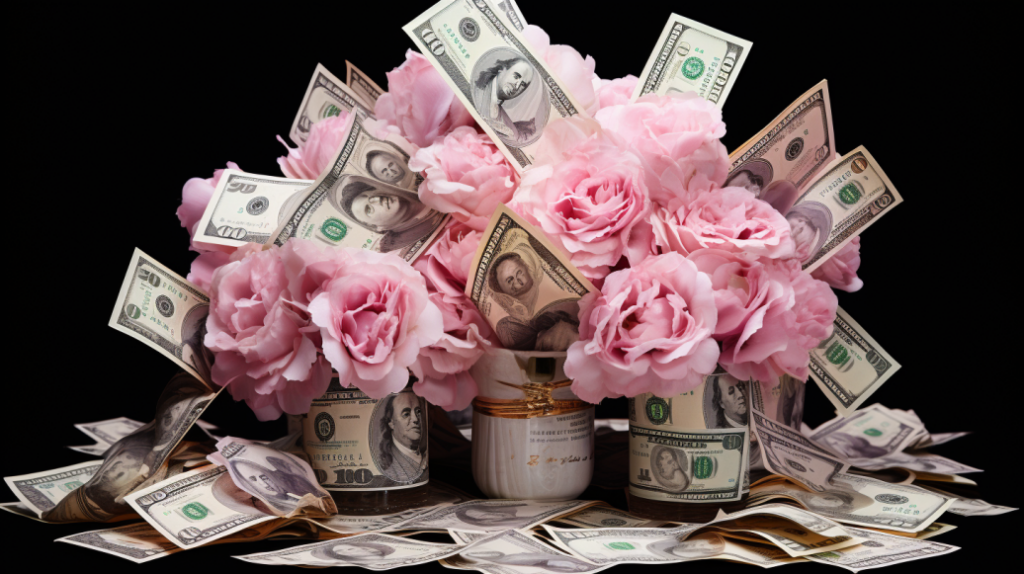
When purchasing peonies, you’ll notice that the cost reflects the expenses of growing, shipping, handling, and the time and labor involved in providing the product and service.
Peonies are known for being an expensive flower due to their delicate blooms and high demand. Growing peonies requires significant time and labor, as farmers carefully cultivate and nurture the plants to ensure healthy and beautiful flowers.
Additionally, peonies are often shipped long distances, which incurs costs for transportation and handling. The price of peonies also takes into account the additional services provided, such as designing and arranging the flowers into beautiful bouquets or floral arrangements.
All these factors contribute to the overall cost of peonies, making them a luxury item for those willing to pay for their beauty and elegance.
Peonies: A Celebrity Favorite

You’ve probably noticed how much celebrities love peonies and how their love for these flowers influences their fans. It’s no secret that peonies have become a favorite among the rich and famous. But why are these blooms so expensive? Let’s take a closer look:
- Exclusivity: Celebrities are often drawn to unique and luxurious items, and peonies fit the bill perfectly. Their rare beauty and limited availability make them highly sought after.
- Instagram-worthy: In the age of social media, celebrities are constantly looking for the perfect photo opportunity. With their lush petals and vibrant colors, peonies make for stunning backdrops, boosting their popularity even more.
- Influencer effect: When A-listers like Hilary Duff, Drew Barrymore, and Gweneth Paltrow are seen with peonies, it not only elevates the flower’s status but also encourages their fans to follow suit.
As a result, the demand for peonies skyrockets, increasing prices and making them an expensive indulgence for both celebrities and flower enthusiasts alike.
Peonies for Medicinal Purposes
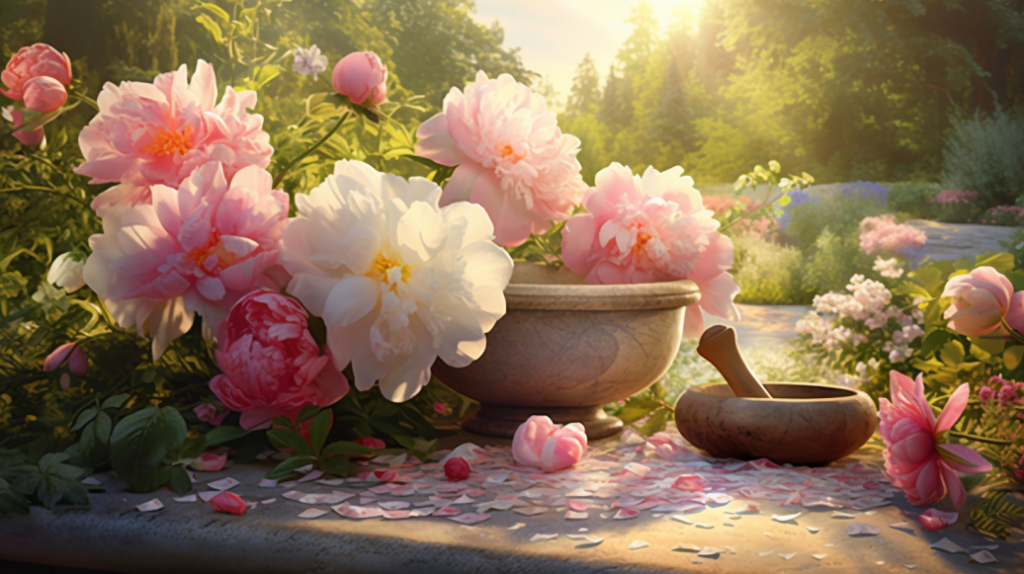
Did you know that peonies have been used for centuries in Chinese medicine due to their immune-boosting and anti-inflammatory properties? These beautiful flowers serve as decorative elements and have been valued for their medicinal purposes.
Peonies have a long history in Chinese medicine, where they’re believed to have various health benefits. They’re known for their immune-boosting properties, helping to strengthen the body’s defense system. Additionally, peonies have anti-inflammatory properties, making them helpful in treating inflammation-related conditions.
In European countries, peonies have also been used to treat bladder and kidney conditions. With such a rich history and numerous health benefits, it’s no wonder that peonies are considered expensive. The high demand for these flowers for decorative and medicinal purposes contributes to their price.
Symbolism of Peonies
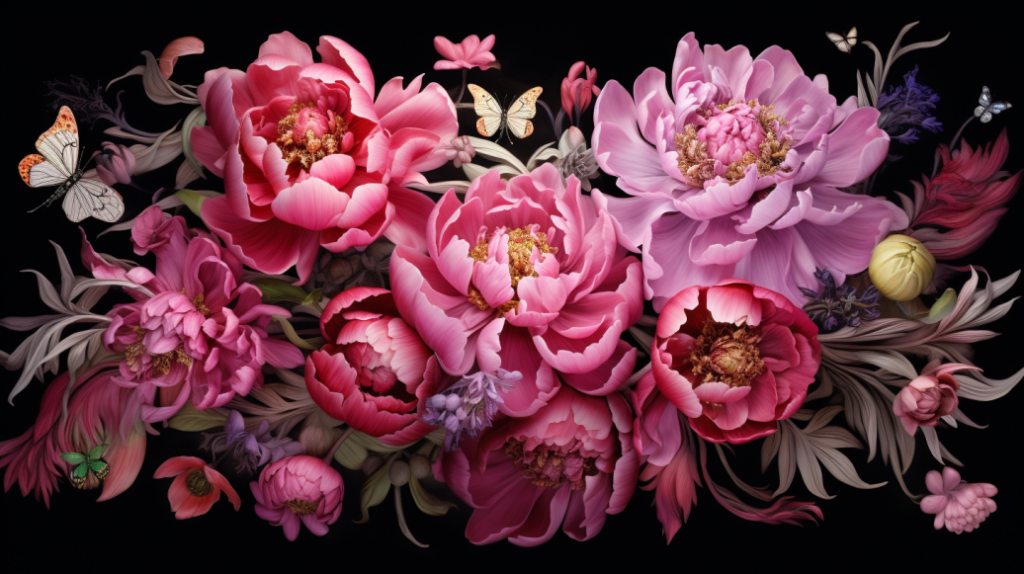
Peonies, symbolizing love, romance, marriage, beauty, and more, hold significant cultural importance in various countries. These exquisite flowers, cherished for their symbolism, are often used in special occasions and celebrations.
Here are three ways peonies are embraced for their symbolic meaning:
- Weddings: A peony bouquet is popular for brides due to its association with love and romance. The lush blooms of peonies create a stunning and elegant centerpiece, symbolizing the beauty and purity of the union.
- High-quality peonies: High-quality peonies, known as the costliest flowers, are sought after for their luxurious appearance. Their vibrant colors and delicate petals symbolizing wealth, nobility, and prosperity make them a desirable choice for those looking to make a statement.
- Celebrity with peonies: Peonies have also become a favorite flower among stars, who often showcase these blooms in social media posts and events. This frequent display further adds to the allure and desirability of peonies, solidifying the flowers’ status as a symbol of beauty and prestige.
High Demand for Peonies
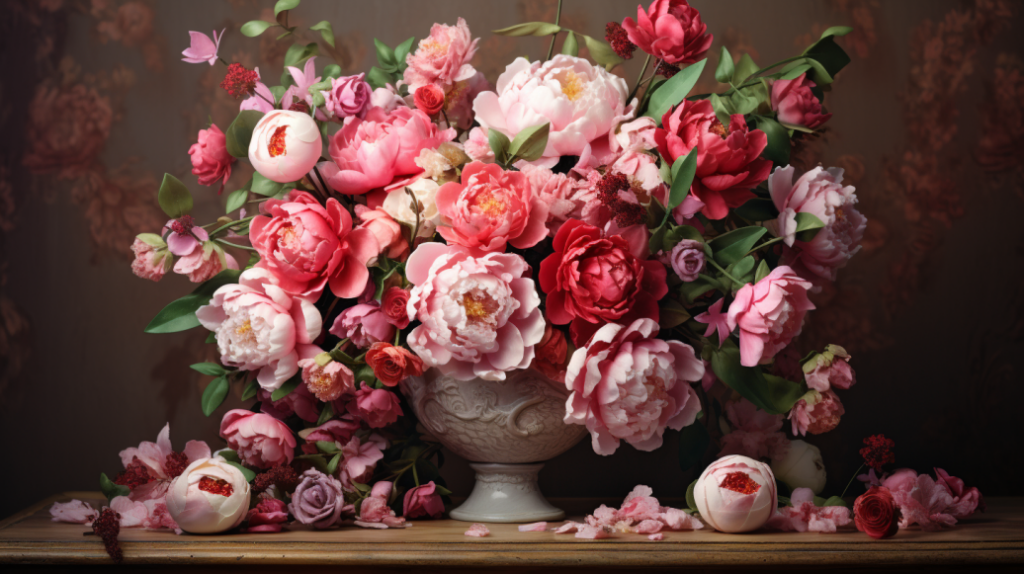
If you’re planning a wedding, you know the high demand for these beautiful flowers due to their popularity and limited supply. Peonies are among the most sought-after flowers for weddings, and their popularity has only increased in recent years.
The problem is that peonies have a very short blooming season, typically lasting only one month in the UK. This limited supply, combined with the high demand from brides and event planners, drives up the price of peonies, making them quite expensive.
Peonies are also in high demand during the gifting season, further contributing to their price. So, if you want to include peonies in your wedding or any special occasion, be prepared to pay a premium for these stunning flowers.
The Logistics of Shipping Peonies
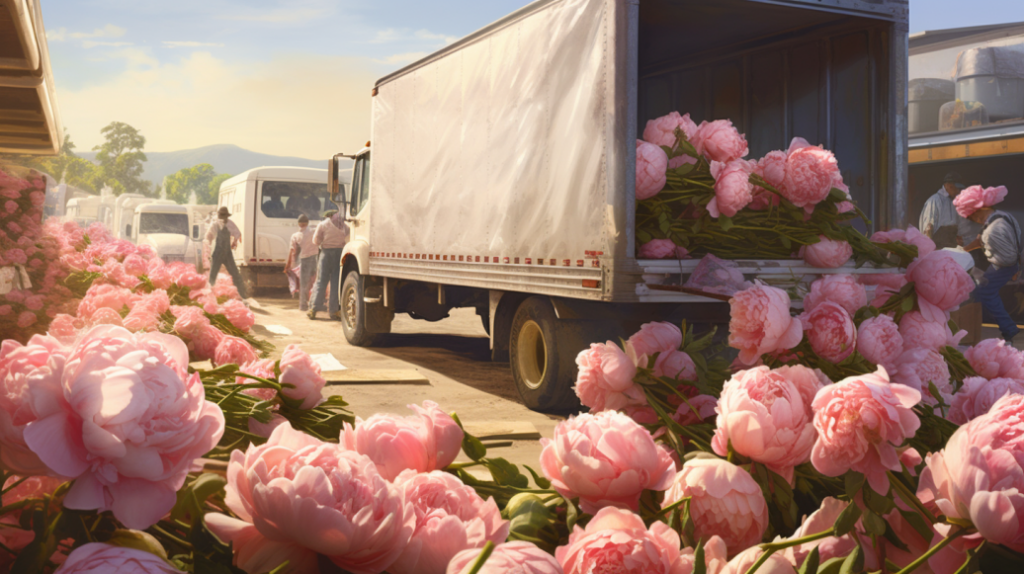
When shipping peonies, you’ll need to consider the perishable nature of the flowers, suitable packaging materials, rush shipping, and the delivery distance, all of which contribute to the cost.
Peonies are delicate and require special care during transportation to ensure they arrive fresh and vibrant. To help you visualize the logistics involved in shipping peonies, imagine:
- A team carefully placed each peony stem in protective packaging, cushioning them to prevent any damage during transit.
- Rushing the packaged peonies to the shipping facility, they’re immediately loaded onto temperature-controlled trucks or planes to maintain their freshness.
- The delivery vehicles swiftly cross the distance, taking the quickest routes to ensure the peonies reach their destination quickly.
As you can see, the expensive shipping costs of peonies are justified by the meticulous care and attention required to preserve their beauty and quality throughout shipping logistics.
The Time-Intensive Process of Handling Peonies

Taking care of peonies requires patience and precision as you carefully clean, strip, and hydrate each stem before they can be designed and sold. This time-intensive process is necessary to ensure that the peonies are in the best possible condition for arranging and delivering to customers. Handling peonies involves several steps, each taking a significant amount of time.
| Peony Handling Process | Time |
|---|---|
| Cleaning | 30 min |
| Stripping | 20 min |
| Hydrating | 1 hour |
| Designing | 45 min |
| Selling | 15 min |
The labor-intensive nature of handling peonies contributes to their high price. Each stem requires individual attention and care, which takes time and effort. Additionally, the delicate nature of peonies means that extra precautions must be taken to ensure their longevity. These factors combined make peonies a luxurious and sought-after flower, and their higher prices reflect the time and effort involved in their handling process.
Longevity of Peonies
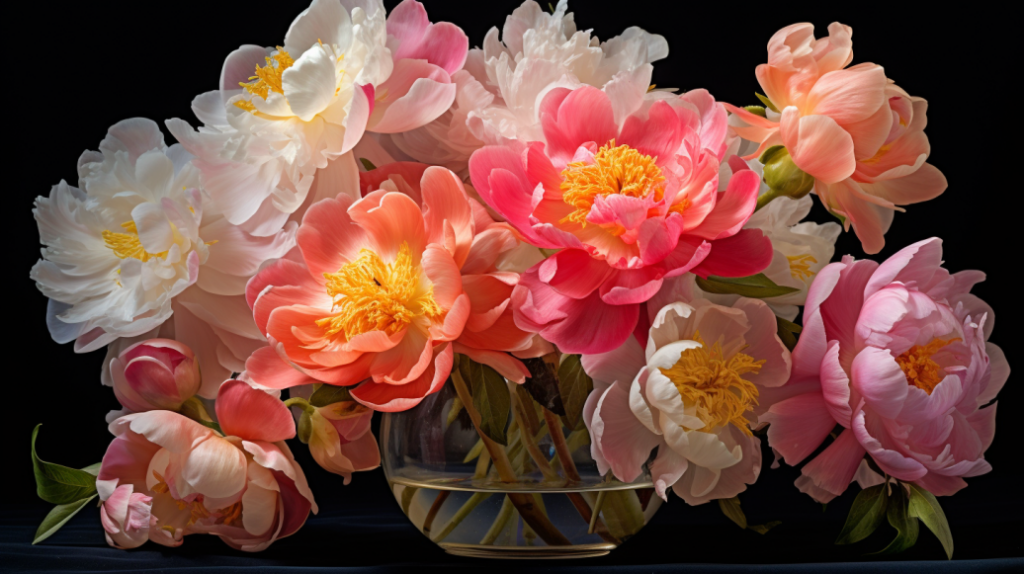
With proper care, you can extend the lifespan of peonies beyond their initial 7-10 days, allowing you to enjoy their beauty for even longer. Here are three tips to help you maximize the longevity of your peonies:
- Trim the stems: Before you put your peonies in a vase, trim about an inch from the bottom of each stem at a diagonal angle. This action aids the flowers in absorbing water more efficiently, which helps keep them hydrated and fresh for an extended period.
- Change the water regularly: Given their sensitivity to bacteria, changing the water in the peonies’ vase is essential every two days. This action helps prevent the buildup of harmful microorganisms that could reduce their lifespan.
- Keep them cool: Peonies are best suited to cool temperatures, so you should position them in an excellent spot and not be exposed to direct sunlight or heat sources. This placement will help slow down their blooming process and extend their longevity.
Delicate Nature of Peonies
To ensure the longevity of your delicate peonies, handling them with care during transportation is essential to avoid any breakage. Peonies are known for their delicate nature, making them prone to damage if improperly handled. These fragile flowers can easily break or lose their petals during transit.
This fragility adds to the challenges of transporting peonies and increases the likelihood of them getting damaged. When peonies are damaged, it affects their appearance and quality, significantly impacting their price. The demand for peonies remains high due to their beauty and popularity, but their delicate nature and transportation challenges contribute to the expensive price tag.
Therefore, taking extra care in the handling and care of peonies is crucial to protect your flower budget and ensure you receive the best quality blooms.
Refrigeration Requirements for Peonies
Now, let’s dive into the refrigeration requirements for peonies.
It’s crucial to understand that peonies need to be kept in a cooler to maintain their freshness and extend their lifespan. Without proper refrigeration, these delicate flowers may quickly wither and lose their beauty.
Here are three key aspects to consider when it comes to refrigerating peonies:
- Temperature control: Peonies require a cool environment to thrive. Keeping them around 34 to 36 degrees Fahrenheit (1 to 2 degrees Celsius) ensures their longevity.
- Humidity levels: Peonies, which favor moderate humidity of around 80 to 90 percent, thrive in conditions that prevent them from becoming overly dry or too moist, ensuring their optimal health.
- Air circulation: Adequate air circulation is essential for peonies. It helps prevent the buildup of ethylene gas, which can accelerate the wilting process. Good airflow also aids in maintaining a consistent temperature and humidity level within the cooler.
The Rarity of Peonies
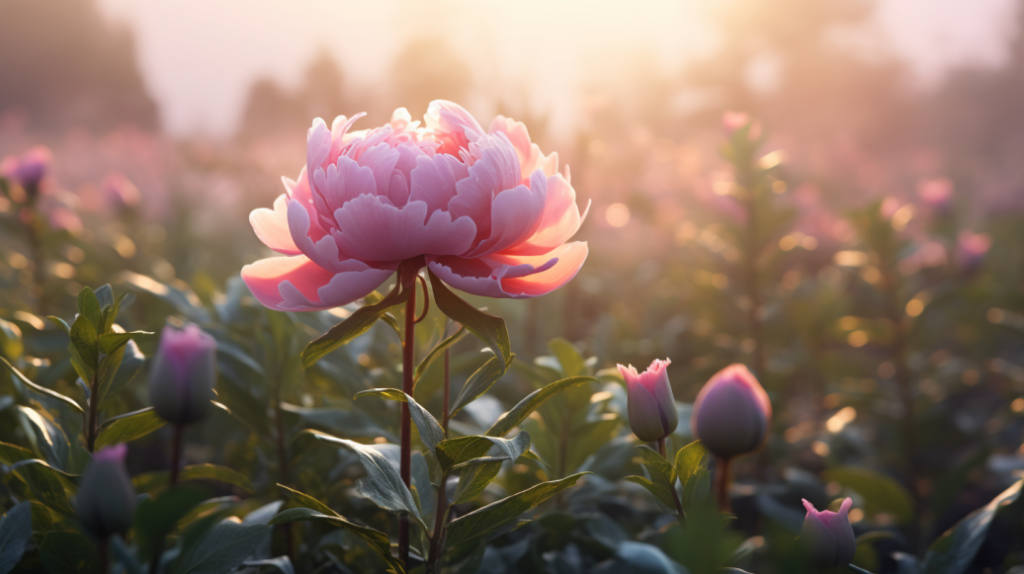
You may have noticed that peonies are challenging to find, and their availability is limited. Their rarity and high demand contribute to this scarcity.
Peonies are only available during the spring season, from April to July, and they grow well in only some areas. They’re native to Asia, North and Western America, and Southern Europe. Peonies become a highly sought-after flower because of their limited growing regions and short blooming seasons.
The high demand for peonies and their limited availability drive up the price. Buying peonies out of season can be expensive, as they must be imported from different parts of the world. So, if you’re looking to add peonies to your floral arrangements, be prepared to pay a premium for these beautiful blooms.
The Complexities of Growing Peonies
Growing peonies requires careful attention to suitable climate, proper soil preparation, and regular watering and fertilization. The complexities of growing peonies contribute to their expensive price tag. Here are three reasons why growing peonies can be a complex endeavor:
- Climate requirements: Peonies thrive in temperate climates with cold winters and mild summers. Finding a suitable environment can be challenging, as peonies may struggle in extreme heat or cold regions.
- Soil preparation: Peonies require well-drained soil that’s rich in organic matter. Achieving the perfect soil composition involves adding compost, adjusting pH levels, and ensuring proper drainage.
- Care and maintenance: Peonies demand regular watering and fertilization to encourage healthy growth and abundant blooms. They also require careful pruning, disease prevention, and pest control measures.
Considering these complexities, it’s no wonder that growing peonies can be labor-intensive and time-consuming, ultimately contributing to their expensive price in the market.
Size Matters: The Bloom of Peonies
Achieving the desired bloom size can be challenging for you as a grower due to the varying seasons and weather conditions. Peonies are known for their brilliant flowers; customers expect nothing less than dream blooms from you.
However, ensuring that your peonies have beautiful blooms of an acceptable size is a challenging task. Harvesting the peonies at the right time is crucial to achieve the correct bloom size, but with changing seasons and unpredictable weather, this can be a daunting challenge.
You put immense effort into watering and fertilizing your peonies, hoping they’ll reach the desired size. It’s a delicate balance, but seeing those peonies blooming at the correct size is truly a sight to behold.
The Role of Middlemen in the Peony Market

When ordering peonies, it’s essential to consider the impact of middlemen on the price. These intermediaries play a crucial role in the peony market, but their involvement can make peonies more expensive for consumers like you. Here’s why:
- Increased Costs: Middlemen work with local florists to source and distribute peonies. They add a markup to cover expenses such as transportation and storage. This additional cost gets passed on to you, making peonies pricier.
- Quality Control: Middlemen ensure that the peonies you receive are high quality. They carefully select the freshest blooms and discard any damaged or subpar flowers. This attention to detail ensures that you get the best peonies but also adds to the overall cost.
- Streamlined Process: Middlemen streamline the supply chain, efficiently connecting peony growers to florists. They handle logistics and manage inventory, saving time and effort for both parties. However, these services come at a price, contributing to the expensive nature of peonies.
Frequently Asked Questions
Are There Any Environmental Concerns Associated With Peony Production?
There are indeed environmental concerns associated with peony production. Pesticide use, water consumption, and greenhouse gas emissions are some of the factors that contribute to the higher cost of peonies.
How Do Peonies Compare to Other Flowers in Terms of Cost?
Peonies, compared to other flowers, can be pretty expensive. They are in high demand and have limited availability, leading to higher prices. However, their beauty and uniqueness make them worth the cost.
What Are Some Popular Uses for Peonies Besides Decoration?
Peonies have various popular uses besides decoration. They are often used in bouquets, floral arrangements, wedding decor, and skincare products. Their versatility makes them highly sought after and adds to their value.
Are There Any Specific Cultural or Historical Meanings Associated With Peonies?
Are there specific cultural or historical meanings associated with peonies? Yes, peonies have deep symbolism in various cultures, representing prosperity, honor, and beauty. They have been treasured for centuries and hold significant value.
How Do the Prices of Peonies Vary Based on Their Color or Variety?
The prices of peonies can vary based on their color or variety. Factors like rarity and demand play a role in determining their cost. So, depending on the type you choose, prices may differ.
Conclusion
In conclusion, peonies are expensive for a variety of reasons. They’re a favorite among celebrities, used for medicinal purposes, and hold symbolic meaning.
Their high demand and rarity contribute to their elevated price. The complexities of growing peonies and the size of their blooms also impact their cost.
Finally, middlemen play a role in the peony market, increasing prices.
All these factors combined make peonies a luxurious and sought-after flower.
